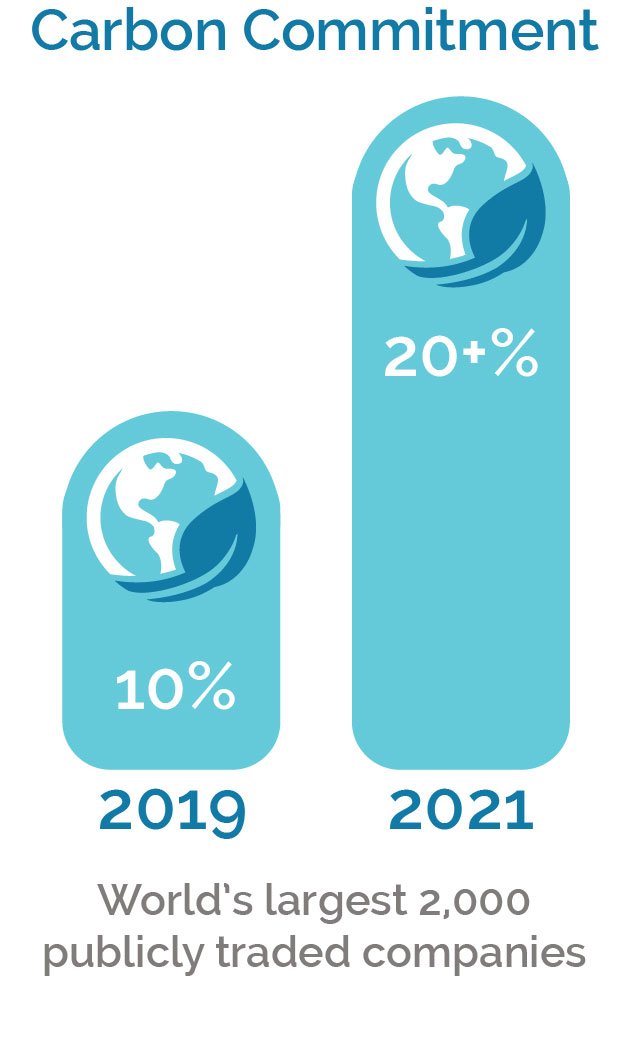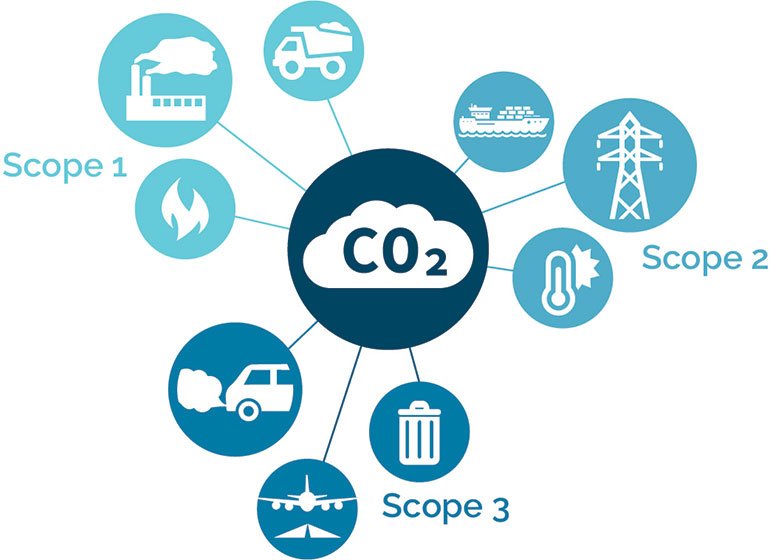Here, ESA continues our series exploring the “road to carbon neutrality.” ESA’s scientists, engineers, and planners are uniquely qualified to bring strategic technical consulting services to clients in support of progressing toward a decarbonized economy. Join us as we address key issues, sectors, and concepts that, together, make up the “all of the above” approach necessary to achieving success.
While carbon neutral commitments by local, state, and national governments are widespread and increasing, the private sector has become just as active in this endeavor, if not more so.

As of 2021, more than 20 percent of the world’s largest 2,000 publicly traded companies have made a carbon commitment, roughly twice as many as in late 20191. Driven by shareholder pressure and a general rising interest from investors, citizens, and consumers, pledges of “net zero,” “carbon neutral,” and “climate neutral” have become common even among emissions-intensive industries.
However, there is wide disparity in how these terms are being used, and the devil is in the details. As ESA has learned from working with its clients, imprecise terminology prevents clarity in target setting and creates confusion in the marketplace. With time running out to stabilize the climate, it is ever more critical that these terms have clear meaning and are widely understood by stakeholders.
Setting the Boundary
Foremost, a business’s carbon neutral pledge must be clear about its boundary and the extent of its commitment—does it cover the operations of the entire company, or just certain divisions or geographies? Does it cover only the direct emissions from sources it owns or controls, or does it extend to indirect emissions from other sources over which it has limited influence but that are integral to its business? In greenhouse gas (GHG) management parlance, these distinctions are described by scope:
 Scope 1 emissions are direct GHG emissions from sources owned or controlled by the company, such as furnaces, vehicles, or boilers.
Scope 1 emissions are direct GHG emissions from sources owned or controlled by the company, such as furnaces, vehicles, or boilers.- Scope 2 emissions are indirect GHG emissions resulting from purchased and consumed electricity, steam, heat from natural gas combustion, and/or other forms of heating/cooling that are generated by another entity (e.g., a utility).
- Scope 3 emissions include indirect GHG emissions that occur because of business activities, but are generated by sources not owned or controlled by the company—i.e., those associated with its supply chain and the downstream impacts of its products or services. Examples include emissions associated with staff commuting, business travel, solid waste disposal, and purchased materials or services.
At minimum, a carbon neutral commitment should include an entity’s Scope 1 and Scope 2 emissions. Scope 3 is where things can get interesting—and more difficult to measure. The inclusion of Scope 3 emissions in inventories and targets is generally considered voluntary, but for office-based organizations many sources of Scope 3 emissions (e.g., paper use and business travel) contribute as much or even more to their total carbon footprint than Scope 1 and 2 sources. Thus, we are starting to see more inclusion of Scope 3 in emissions reduction targets.
Achieving the Target
In addition to what it covers, it is also important for a corporate carbon neutral pledge to state how the target will be met. Will the target be accomplished directly by reducing emissions from the sources you control or influence, or will it happen indirectly through the use of Renewable Energy Certificates (RECs) or verified carbon offsets. A carbon neutral target may sound impressive, but stakeholders generally want to know what a company is actively doing to reduce its emissions. An overreliance on RECs or carbon offsets can open a company up to claims of “greenwashing” or solicit criticism from stakeholders who say the company is not doing all it can to reduce its emissions through its own policies and management systems. Carbon offsets also rely on robust, transparent, and well-run carbon markets, which are still in their infancy. In general, strategies for achieving carbon neutrality should emphasize emissions reductions through energy efficiency, changes to operations and supply chains, and zero carbon fuels and technologies, before turning to RECs and offsets. For credibility regarding carbon neutral claims, RECs and offsets should be third-party verified and purchased from a reputable seller or registry to ensure that they are “real, additional, permanent, quantifiable, and verified.”
Accountability
Created to make the economic and financial investing world more aware of the risks and opportunities associated with managing GHG emissions, CDP (formerly known as the Carbon Disclosure Project) has emerged as the leading global registry of emissions inventories and carbon neutral commitments. Member organizations are asked to annually disclose detailed information and data related to all aspects of their sustainability plans and programs, including GHG inventory and reduction target information. In addition to supporting institutional investors in assessing the possible impacts of climate change on the value of their portfolios, the CDP’s reporting and scoring program encourages businesses to pay closer attention to their GHG emissions and overall sustainability performance. With the recent emergence of environmental, social, and governance (ESG)-focused investing, CDP’s impact on the large-scale movement of investment dollars has continued to grow in importance and influence.
CDP scoring favors companies that commit to actual reductions that align with the goals of the Paris Agreement and the related Science-Based Targets initiative (SBTi). Approaches to setting targets that align with SBTi while balancing direct and indirect reductions, including the effective and appropriate use of RECs and carbon offsets to achieve carbon neutrality, as well as ESG investing, will be subjects in upcoming posts to The Road to Carbon Neutrality.
For more information about ESA’s broad range of services to help you reach carbon neutrality, reach out to Jeff Caton and Chris Easter.
1 NewClimate Institute & Data-Driven EnviroLab, 2020. Navigating the Nuances of Net-zero Targets.








